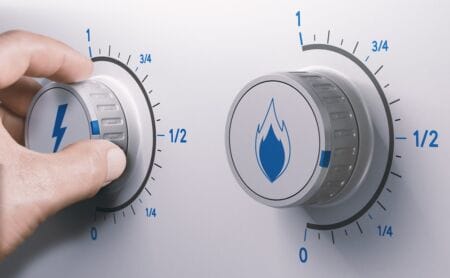Contents
ToggleWhat we'll cover...
A selection of the finest radiator ideas to match up with minimalist interiors.
Heating hacks to enhance an understated aesthetic
Minimalism isn’t just a design trend – it’s also a mindset. It’s about stripping things back, choosing quality over quantity, and giving every item a purpose and a place. It’s clean lines, neutral tones, and a sense of calm in every corner.
But here’s the challenge in identifying the best radiator ideas for minimalist homes: heating doesn’t always play by minimalist rules. Radiators can be bulky, fussy, or just plain unsightly. And in a space designed to breathe, the wrong radiator can quickly clutter the vibe.
Luckily, modern radiator design has stepped up to the plate. From seamless flat panel models to slim vertical radiator styles and construction with sustainable materials, there’s now a wide range of radiators that tick both form and function boxes – ideal for minimalist homes that don’t want to compromise on comfort or looks.
Here’s your detailed guide to the best radiator ideas for minimalist interiors – with style, space and simplicity at heart.
1. Flat panel radiators - The minimalist staple
Minimalist design thrives on visual clarity. That’s where flat panel radiators score big. With smooth, featureless surfaces and a low-profile finish, they can blend effortlessly into the background or become a quiet and understated focal point of a space.
Why they work so well:
- Their clean, linear shape ensures a streamlined look
- They’re available in ultra-slim depths, ideal for rooms with tight layouts
- Matte and satin finishes avoid reflective noise in calm interiors
Whether you choose horizontal or vertical orientation, a flat panel radiator is a minimalist essential. A crisp, functional heating form that doesn’t beg for attention.
Style suggestion: Pair a flat panel radiator with minimalist Scandi furniture and soft neutral walls for a cohesive look that feels thoughtful but never busy.
2. Vertical radiators - Space-saving and sculptural
Wall space is sacred in a minimalist home. So, if you’re working with an open-plan layout, narrow hallways or compact bedroom areas, vertical radiators are your best bet. Our guide, Vertical or horizontal radiators: Which is right for you? has a deeper insight on the best instances to go vertical.
Key advantages:
- They incorporate height over width, freeing up notable wall space for storage, art, imagery or any other use
- Their upright form brings architectural interest without excess clutter
- Perfect for alcoves, next to doors, or beside wardrobes
Where they shine:
- In small bedroom spaces where a horizontal radiator would restrict the layout
- In kitchen areas where wall space is already dominated by cabinetry
- In bathrooms, where floor real estate is virtually always at a premium
BestHeating tip: Select a tall, narrow radiator in a matching wall tone to create a sense of vertical flow and continuity.
3. Wall-matching finishes - Radiators that disappear
Nothing says minimalist quite like a radiator that melts into the wall. Coloured radiators that align with their surroundings help keep the eye moving, reducing visual noise and keeping the space serene.
How to do it:
- Match your radiator’s finish to the exact wall shade for a blended, built-in look
- Use soft white on white, grey on grey, or beige on taupe to create tonal balance
- For bold minimalism, choose monochrome: a black radiator on deep charcoal or navy
Bonus points:
- Match the valves and pipe covers too – silver or brass can distract from the clean effect
- Consider installing flush skirting boards or shadow gaps to reinforce the sense of simplicity
This is minimalism at its most literal, and most effective in turn.
4. Multi-function radiators - Design that works overtime
In a home where every item must prove value to earn its place, multi-purpose heating solutions are a minimalist’s dream. These radiators offer function and form in equal measure, without a demand for extra space.
Top examples:
- Radiator benches that double up as hallway seating or shoe storage
- Slimline heated towel rails that combine heating and practicality in bathrooms
- Shelf-style radiators with integrated ledges for subtle display or storage
Pro tip: Look to utilise these styles in transitional spaces that might be susceptible to a build-up of clutter, such as entryways, cloakrooms or utility rooms. The result? Streamlined warmth with no waste.
5. Smart radiators - Hidden control, visible comfort
Minimalism doesn’t just stop at looks; it’s all about lifestyle too. That means cutting clutter, decreasing waste, and letting tech do the hard work quietly. Enter: smart heating solutions.
Why smart radiators suit minimalist homes:
- No clunky dials or wall thermostats – just simple app control or voice commands
- Zonal scheduling for tailored warmth (and reduced energy bills)
- Lower energy use = lower carbon impact (and a smaller carbon footprint)
Many electric radiators now come complete with built-in digital thermostats and timer programming, which removes the need for external controls or accessories.
BestHeating insight: Team smart thermostatic radiator valves (TRVs) with minimalist central heating radiators to get total room-by-room control with no compromise on appearance.
6. Material matters - Aluminium and steel for sustainable style
Minimalist homes tend to lean towards natural materials and low-impact design. Radiators can (and should) be part of that ethos.
Materials to consider:
- Aluminium radiators: Lightweight, quick to heat up, fully recyclable – ideal for responsive warmth and eco-credentials
- Mild steel: Durable and smooth, often used in panel designs and available in powder-coated finishes
Avoid overly ornate materials or mixed finishes where possible. Consistency is key in keeping things calm and clutter-free.
7. The artful radiator - Understated impact
Just because you’re keeping things minimal doesn’t mean you can’t make a statement with your home heating – you just need to do it clearly and intentionally. Some designer radiators act as sculptural elements, blending seamlessly into the aesthetic while offering a moment of interest.
Good minimalist design includes:
- Geometric shapes or modular panels
- Monochrome finishes with subtle detailing
- Loop or ladder-style designs with repetition and rhythm
Where to use them: In hallway nooks, stairwell landings, or blank bedroom walls. Basically, any spot where a clean, artistic form can provide a welcome double pivot as a heat source.
What to avoid in a minimalist heating setup
If you’re aiming for simplicity, it’s best to steer clear of radiator design pitfalls that add noise or visual weight.
Avoid:
- Overly decorative grilles or panel textures
- Glossy finishes that reflect light to an excessive extent
- Exposed radiator valves and pipework – go for minimalist valve kits in matching finishes
- Radiators that are simply too big to suit the space (even if they incorporate a modern design)
BestHeating tip: Always size your radiator properly. Use a BTU calculator to get the heat you need without oversizing the unit.
Layout lessons: Where to position radiators in a minimalist home
Keep radiators:
- Aligned with other fixtures – windows, cabinets, or architectural lines
- Integrated into symmetrical layouts to reinforce visual balance
- Away from focal points unless they’re a deliberate feature
And never:
- Cram a radiator behind furniture (wasted heat and visual chaos)
- Place them opposite bold feature walls (they’ll compete)
- Leave pipework as an afterthought
Design insight: The best minimalist heating setups are invisible in intention, even when the radiator itself is beautifully visible.
Radiators that complement, not complicate from BestHeating
Minimalist homes are all about careful editing. And your heating should be part of that plan, rather than an afterthought tacked on at the end.
Whether you want your radiator to vanish quietly into the background, or deliver a subtle layer of style, modern radiator styles provide a wealth of options that support your ideal aesthetic and your lifestyle. And there’s plenty more inspiration to be found in the likes of our ultimate guide to radiator design, and guide on how to choose the perfect radiator for your interior style.
So, heat your home with intention. Choose clean lines, smart control, and finishes that work with your palette, rather than against it. Less fuss. More flow. Maximum calm.
Be sure to let us know about your minimalist heating upgrades in the comments, or by reaching out to us on Instagram, Facebook or X.
John is a Research Specialist for the Best Heating Advice Centre, where for over nine years he has dedicated himself to demystifying home heating for our customers. He specialises in creating clear, data-driven guides and how-to articles by collaborating directly with our team of certified heating experts and product engineers.
His work, built on a foundation of journalistic research, has helped millions of readers make confident and informed decisions about their home heating. When he’s not breaking down the heat output differentials from radiators to heated towel rails, John fancies himself as a fine football and music connoisseur.









